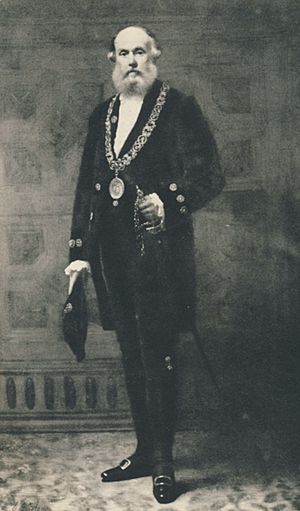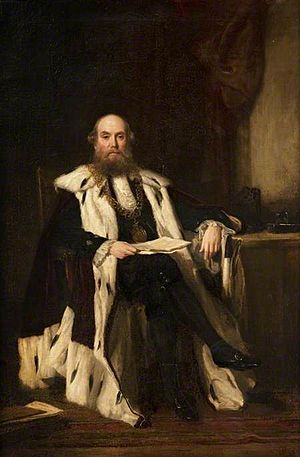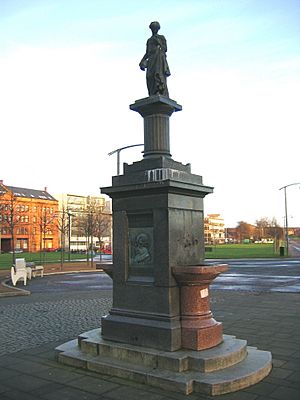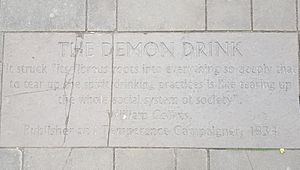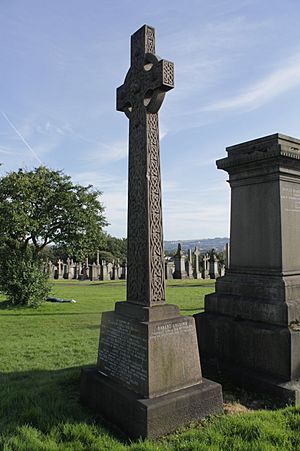William Collins (Lord Provost) facts for kids
Quick facts for kids
William Collins
|
|
|---|---|
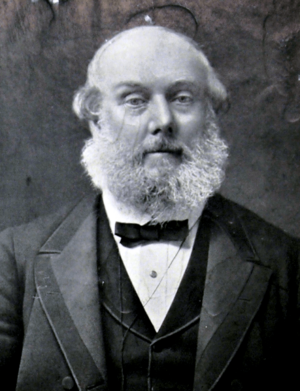 |
|
| Lord Provost of Glasgow | |
| In office 1877–1880 |
|
| Preceded by | James Bain |
| Succeeded by | John Ure |
| Glasgow City Councillor for Fifth Ward |
|
| Assumed office 1868 |
|
| Personal details | |
| Born | 12 October 1817 Glasgow |
| Died | 20 February 1895 |
| Parents |
|
Sir William Collins (1817–1895) was an important Scottish publisher. He was also a leader in the temperance movement, which encouraged people to avoid alcohol. He served as Glasgow's Lord Provost (like a mayor) from 1877 to 1880.
He was the first Lord Provost of Glasgow who completely avoided alcohol. This earned him the nickname Water Willie. In politics, Sir William was a strong supporter of the Liberal party. He also belonged to the Free Church. A street in Glasgow, Collins Street, is named after him.
Contents
William Collins' Early Life and Education
William Collins was born in Glasgow on October 12, 1817. His father, William Collins, was a respected publisher. He was also well-known for supporting the temperance cause in Scotland. His father worked hard to help churches grow across Scotland.
William's mother was Jane Barclay. He had a brother and a sister, but they both passed away young. William went to school in his hometown. When he was still quite young, he started working as an apprentice in his father's business.
In 1841, the family company, William Collins, Sons, began to focus on printing Bibles. At that time, the family lived at 113 Montrose Street. In 1843, both William and his father left the official Church of Scotland. They joined the new Free Church of Scotland.
Growing the Family Business
In 1848, William Collins joined his father as a partner. This was when their publishing company started making stationery. After his father died in 1853, William continued to run the business.
In 1865, he brought in two people who had helped manage the company as new partners. Three years later, his two older sons also became partners. The business was then known as William Collins, Sons & Co.. They also had an office in London.
Under this new management, the business grew very quickly. By 1880, it was reorganized under the name William Collins, Sons & Co., (Limited). It became a large company that published, printed, bound books, and made stationery. It was one of the biggest companies of its kind outside of London. Sir William and his family owned all the shares. The main buildings were located on Stirling Road, with fronts on Taylor Street and St. James' Road.
Serving as a City Leader
Sir William became a member of the Glasgow City Council in 1868. He represented the fifth ward and was chosen four times without anyone voting against him. In 1873, he was elected as a Magistrate, which is a type of judge.
In 1877, he was chosen as the Lord Provost of Glasgow. He took over from Sir James Bain. Later, John Ure became the next Lord Provost after him. During this time, Collins lived in a large house at 3 Park Terrace East, which overlooked Kelvingrove Park.
The year 1878 was a difficult time for businesses. There was a big problem when the City of Glasgow Bank failed. About 30,000 people needed help from public charities for several months. During this crisis, Sir William gave his own money and worked hard to help people. His efforts greatly reduced hardship and prevented other problems. He also helped create the Glasgow Liberal Association in 1878. From 1888 to 1894, he was involved with the Glasgow School Board.
Honors and Recognition
People recognized Sir William's hard work and value throughout his life. For example, the Incorporation of Stationers, where he had been president, gave him a special award. It was an illuminated address, signed by members, inside a silver-gilt box. They gave it to him when he became Lord Provost.
His employees also congratulated him when he had been in business for fifty years. They gave him an illuminated address inside a silver box. After his time as Lord Provost ended in 1880, the City Council gave Lady Collins a full-length painting of Sir William. At the same time, Sir William received a full-length painting of Lady Collins. Council members and other public groups paid for these paintings.
On October 29 of the same year, a public fountain was opened. It was designed by John Mossman and built in the Green near the Justiciary Buildings. This fountain was a gift from his friends in the temperance movement. About 50,000 people attended the opening, including many representatives from temperance groups. Lord Provost Ure gave a speech praising Sir William when accepting the fountain for the city. To top off these many honors, which were very rare locally, he was made a knight by Queen Victoria. This happened at Holyrood Palace on August 26, 1880.
Death and Burial
Sir William Collins passed away on February 20, 1895. He is buried in the Glasgow Necropolis. His grave is located on the eastern side of the upper plateau's north section.
Family Life
On June 24, 1845, he married Annabella Glen (1822–1862). She was the daughter of Alexander Glen from Glasgow. Annabella passed away on September 12, 1862.
He married his second wife, Helen Jamieson, on September 26, 1865. She was the daughter of Robert Jamieson from Glasgow. Helen died in 1893.
His oldest son, William (1845–1906), also worked in the family company. Sir William Collins had 11 children in total.


